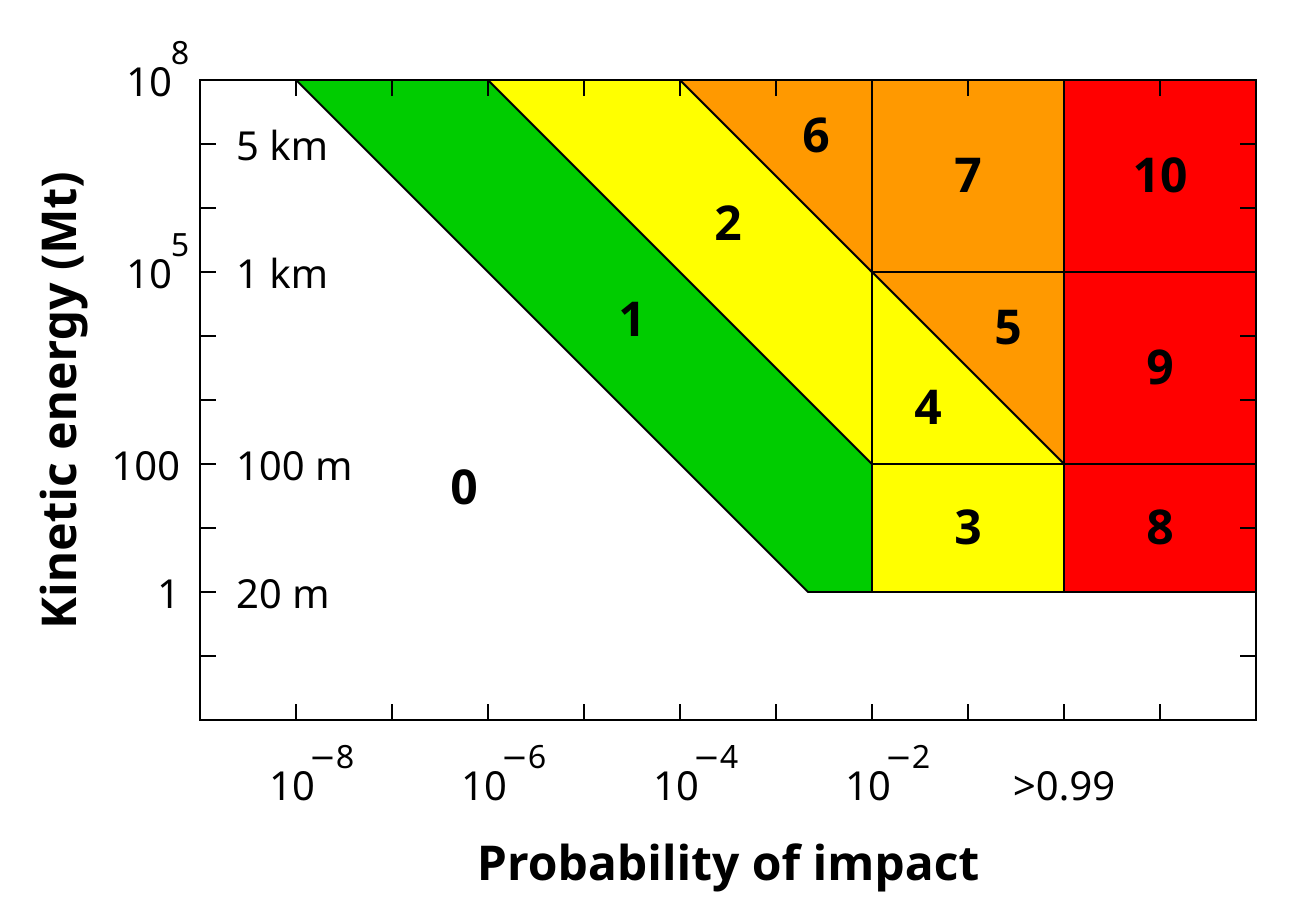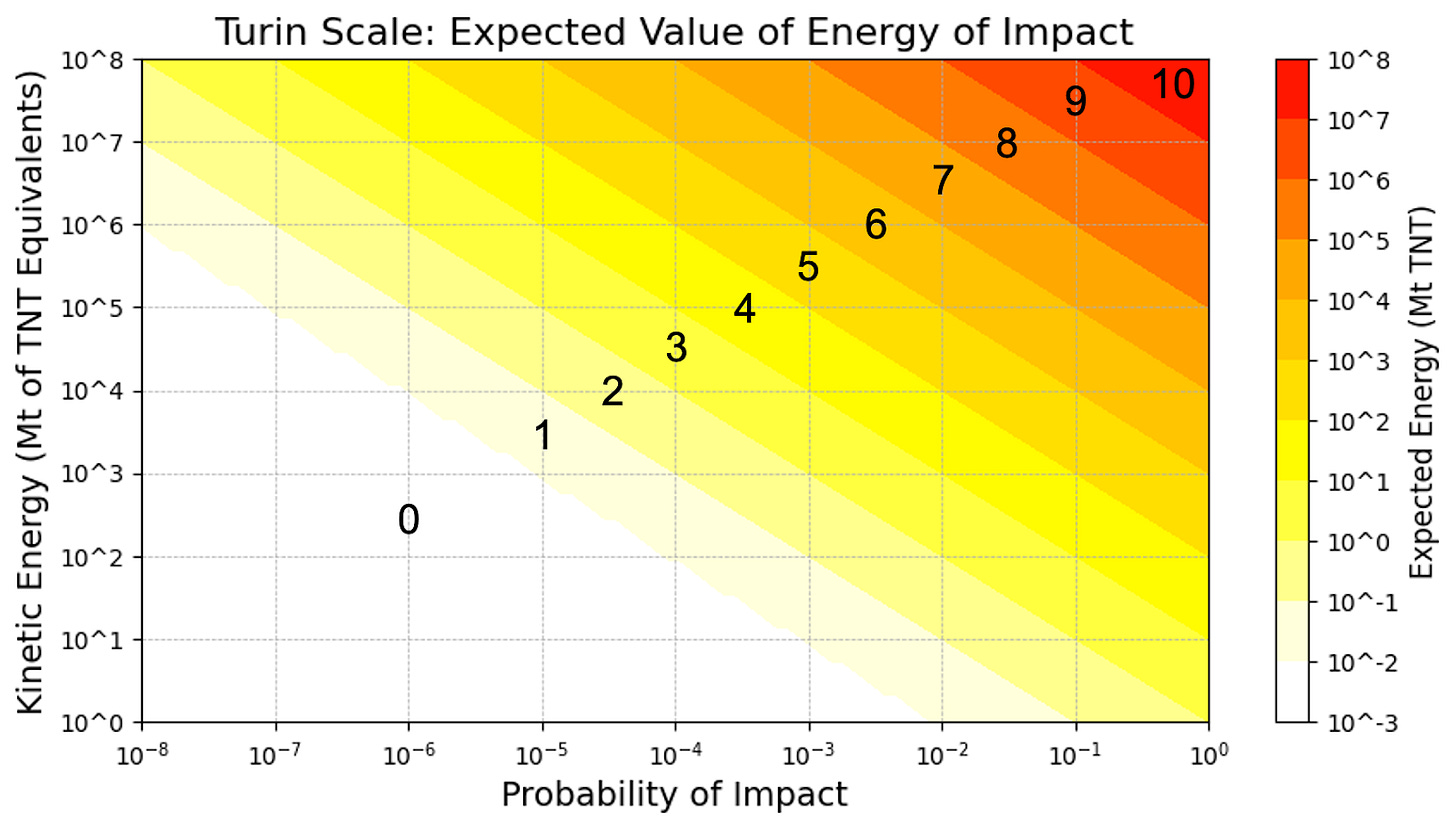Scaling Surprise in the Southern Skies
YR4, Italian Cities, the Chicxulub Impact, and Vera Rubin
1. YR4 Afraid of Five? Because Five Eight Nine!
As of this morning, the impact probability of our asteroid friend, 2024 YR4, is down to ~0.002%. If it were to indeed impact Earth, there’s probably a less than 10% chance it would affect a populated area, and within that, outcomes could range from a Tunguska Event-like airburst leading to a few deaths to a city-destroying catastrophe. And if it were to become dramatically more likely to impact Earth, we could (1) divert it (click the link for a fun google animation) or (2) hold widespread evacuations that may or may not be effective.
Thus, from what we know now about this asteroid, the expected value of damage to our planet is about a hundredth of a death, relegating it from the top million most concerning things going on in the world.
Of course, this was unclear even a few days ago. When the impact probability according to NASA was about 3%, the asteroid posed a legitimate threat. Unfortunately, the public often has an allergy to probabilistic thinking. There’s a joke in forecasting circles that when people see a percentage, they try to pigeonhole it into one of the three possibilities: that the event will happen, that it won’t happen, or that it may or may not happen, essentially a coin flip. Well, a 3% event is quite unlikely to happen, but that’s a far cry from certainty.
Despite this, a lot of commentators, even astrophysicists, went around saying stuff like, “We aren’t worried about this asteroid and expect that this probability will rapidly go to zero as more measurements come in.” Well of course… if there’s a 3% chance of an asteroid hitting Earth, there’s a 97% chance that it won’t hit Earth, and that trajectory will become clear as more measurements come in. But there’s still that 3% chance that instead, the probability could have approached 100%!
2. The Italian Cities that Forecast Our Doom
There’s a scale that should be able to do the work for us of estimating how much we should be worried about an asteroid impact. It’s called the Torino scale, invented by MIT Astronomer Rick Binzel, and named after the location of the conference where it was operationalized.

It’s a good scale, as scales go, and it’s far better than no scale. It’s also much more useful at conveying risk to the public than the alternative, more scientifically precise, Palermo Scale (adopted at another international conference, this time in Sicily, not Piedmont). The Palermo scale is hard for the public to understand for a couple reasons. Firstly, it’s a logarithmic scale where most of the phase space is in negative numbers, so you’ve already lost 80% of the public. Secondly, it communicates how surprising an asteroid is, or rather, how unlikely the trajectory of an asteroid with a potential to impact Earth is, given what we know about the likelihood of asteroid impacts of varying sizes. Science communicators basically ignore this scale, focusing on the Torino scale for these reasons.
However, the Torino scale is also incredibly flawed. And it’s flawed for the same reason that most of the coverage of YR4 has also been misleading. This is because people, including many astrophysicists, are not very good at understanding the risk of low-probability events.
3. My Proposal to Fix the Torino Scale So That it Makes Sense
The values on the scale range from 0 (no hazard) to 10 (certain collision with an asteroid that can cause a global catastrophe and potentially human extinction). However, the boundaries between these levels are unfortunately arbitrary and discrete. For example, on this scale:
A “planet-killing” 5+ km asteroid with a 98% chance of hitting the Earth is classified as a 7, whereas a fairly minor 25m asteroid that has seven orders of magnitude less kinetic energy, but with a 99% chance of hitting the Earth is classified as an 8.
A 1 in 1000 chance of human civilization being mostly destroyed by a 3km asteroid is only a 2 on the Torino Scale. This seems to be really miscalibrated. The 2 and 6 levels directly abut each other along a diagonal axis. Why should a 0.01% change in risk cause a detected object to jump up four levels at once?
There are single points on the graph where four or even five different levels intersect. This is nonsensical and would result in hazard levels ricocheting around dramatically as measurements come in.
I have a proposal to fix it. Just multiply the probability(impact) by the expected kinetic energy (or diameter, alternatively) of the asteroid. Then you can have the scale be increasing orders of magnitude of the expected value of the kinetic energy of the impact. Level 1 starts at 0.01 Mt of TNT equivalents, or a 1% chance of a 1 Mt impact, just big enough to get through the atmosphere and cause some problems. Level 10 is 107 Mt, equal to a 10% chance of an event equivalent to the Chicxulub impact, which was likely to have caused the extinction of the dinosaurs. This scale feels well-calibrated, no? Also, if you need to dial it up to eleven, you have that option!
There are several basic advantages to this modified scale, which I shall call the Turin Scale, since Turin is a simpler version of the city name Torino (work with me here):
It’s simpler, avoids any intersections between more than 2 levels, and eliminates arbitrary thresholds at 99% and 1%, as well as at 100m and 1km sized objects.
It continues to assign even higher levels for objects more massive than 1km sized asteroids. This is actually quite useful because a 10km object is operationally more difficult to divert with a space mission than a 1km or 100m object. Also, there’s a difference between the global weather and agriculture impacts from a ~1km asteroid and, like, the total annihilation of all human life with a ~10km asteroid.
Like the Torino Scale, the Turin Scale cuts off for objects below 10m in size (these would likely fall apart in the atmosphere) and for probabilities below 10-8 where the estimate likely just reflect the uncertainty bounds of the modeling methods and detecting instruments, rather than a true forecast of the likelihood of an object impacting Earth.
There are probably some small improvements that could be made to this scale. For example, it might make sense to adjust the slope of the gradient to weight the kinetic energy slightly higher than the probability of impact, as objects at the very top of the scale are existentially more concerning because of their potential to not just affect current lives on Earth, but also all future lives.
4. Vera Rubin is Coming
We currently only have detected a small fraction of the number of potentially-hazardous objects in our solar system that we expect exist. Systematically detecting the objects on the smaller side of the spectrum, less than a hundred meters or so in diameter, is challenging for the current observatories on Earth, but there’s good news. The Vera C. Rubin Observatory is coming online in Chile as soon as this summer, where one of its chief tasks will be to conduct an astronomical survey of the souther skies, including cataloguing a massive number of small, near-Earth objects. This should increase the number of known, small objects by a factor of 10 or more! The boost in performance from modernized cameras, telescope mirrors, and algorithmic processing makes Vera Rubin far more capable than previous massive sky surveys, such as Pan-STARRS in Hawaii.
This is great for mapping out potentially-hazardous objects, but I’m far more excited for a different reason. And that reason is related to a discovery made by the Pan-STARRS survey. That discovery was the first interstellar object—an object not bound to a star system—observed by humans. In this case, it was observed passing through our solar system, going fast enough to avoid capture by our sun. Vera Rubin should make it possible to catch far more of these interstellar objects, of which now only two(-ish) have been spotted in the sky.
This object was named ‘Oumuamua. Forebodingly, that is the Hawaiian word for “Scout”. And it probably… isn’t alien space junk. But that’s a topic for a future blog post, perhaps in a couple weeks :-)


I think the Turin Scale should definitely go up to 11